





.jpg)
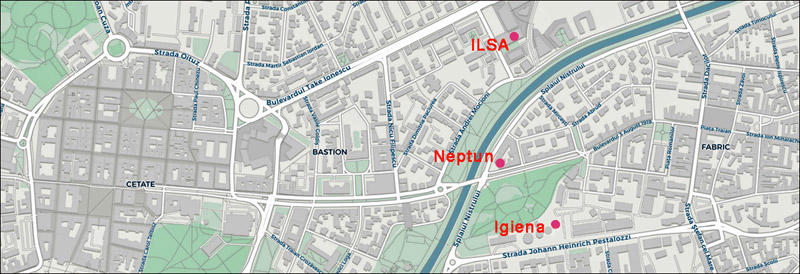




.jpg)
Known to everyone as ILSA, the old Industria Lânii textile factory is long gone, and so is the factory's swimming pool that, over the course of sixty years, has meant so much, for so many.
Using words and pictures, this website tells the story of the people who transformed a simple swimming pool into one of the city's most vibrant focal points, while giving all involved a strong sense of pride and belonging.
This website covers a period of time from the early 1930s to the end of all swimming and water polo activities at the factory's old pool (early 1980s and 1999, respectively).
Using words and pictures, this website tells the story of the people who transformed a simple swimming pool into one of the city's most vibrant focal points, while giving all involved a strong sense of pride and belonging.
This website covers a period of time from the early 1930s to the end of all swimming and water polo activities at the factory's old pool (early 1980s and 1999, respectively).


Visit the History page, which focuses primarily on the highest-achieving athletes and coaches, while the website's Photo pages give recognition to many other deserving swimmers, players and coaches.
ILSA… WHAT DO THESE INITIALS STAND FOR?
After World War I, when Timisoara became part of Romania, the textile factory until then known as Gyapjuipari Részvénytársaság in Hungarian and Wollindustrie Aktiengesellschaft in German, was officially renamed Industria Lânii Societate Anonima, a name that yielded the famous ILSA acronym.
After World War I, when Timisoara became part of Romania, the textile factory until then known as Gyapjuipari Részvénytársaság in Hungarian and Wollindustrie Aktiengesellschaft in German, was officially renamed Industria Lânii Societate Anonima, a name that yielded the famous ILSA acronym.

The factory's Romanian name was not a literal translation of the Hungarian and German names, both meaning Societate pe Actiuni. Instead, the Romanian language had simply embraced the synonymous French term of Société Anonyme.
ILSA, the newly coined word, was quickly adopted by the city's polyglot population. Used in equal measure by Timisoara's Romanian, Hungarian and German speakers, the new word acquired multiple meanings, as it could designate the textile factory, the factory's athletic teams and the swimming pool as well.
Originating from the word "ILSA" and designating anyone associated with the club, the expression "ilsist" soon became part of the city's vocabulary.
ILSA, the newly coined word, was quickly adopted by the city's polyglot population. Used in equal measure by Timisoara's Romanian, Hungarian and German speakers, the new word acquired multiple meanings, as it could designate the textile factory, the factory's athletic teams and the swimming pool as well.
Originating from the word "ILSA" and designating anyone associated with the club, the expression "ilsist" soon became part of the city's vocabulary.
ILSA - A RESILIENT NAME
Technically speaking, the old ILSA name ceased to exist in 1949, when the factory changed its name from Industria Lânii Societate Anonima (ILSA) to Industria Lânii Timisoara (ILT). More name changes followed. In 1950, the athletic club became, albeit temporarily, Flamura Rosie Timisoara, a change initiated by the communist authorities. In its latter years, the club was officially known as Asociatia Sportiva Industria Lânii (ASIL).
Technically speaking, the old ILSA name ceased to exist in 1949, when the factory changed its name from Industria Lânii Societate Anonima (ILSA) to Industria Lânii Timisoara (ILT). More name changes followed. In 1950, the athletic club became, albeit temporarily, Flamura Rosie Timisoara, a change initiated by the communist authorities. In its latter years, the club was officially known as Asociatia Sportiva Industria Lânii (ASIL).

However, none of these name changes altered the way people referred to the factory, its athletic club and pool. Eighty years after it was first coined, the ILSA name was still in use when the factory was demolished at the beginning of the 21st Century.
"ILSA ATHLETE" - A TERM EXPLAINED
Built and owned by the textile factory, the ILSA pool was not only the home base of the factory's own swimming and water polo teams, but also the host of several other clubs, such as Progresul, Voința and CFR during the early years, then later, Clubul Sportiv Scolar Banatul, Scoala Sportiva de Elevi (SSE) and Politehnica.
It was common for athletes to have formally belonged to multiple clubs during their athletic careers, but one thing never changed: they kept swimming and playing at the very same pool.
This website covers not only the factory's own teams, but also the other clubs that activated at the ILSA pool. Throughout this website, the terms "ILSA" and "ILSA athletes" are used in a general sense, to include all those who trained and competed there, regardless of their formal club affiliations.
Built and owned by the textile factory, the ILSA pool was not only the home base of the factory's own swimming and water polo teams, but also the host of several other clubs, such as Progresul, Voința and CFR during the early years, then later, Clubul Sportiv Scolar Banatul, Scoala Sportiva de Elevi (SSE) and Politehnica.
It was common for athletes to have formally belonged to multiple clubs during their athletic careers, but one thing never changed: they kept swimming and playing at the very same pool.
This website covers not only the factory's own teams, but also the other clubs that activated at the ILSA pool. Throughout this website, the terms "ILSA" and "ILSA athletes" are used in a general sense, to include all those who trained and competed there, regardless of their formal club affiliations.
A PLACE NOT ONLY FOR CHAMPIONS
Reflecting the city's melting pot of ethnicities, ILSA was a colorful place where folks of all ages, professions and athletic skills, came together to form a community that quite often felt like family.
Some club members achieved significant athletic success, but the ILSA pool was also home to many athletes who may have had some success on the local stage, perhaps even in regional and national competitions, but without making it to the very top. The History page of this website may not mention their names, but such deserving athletes are extensively featured in the site's Photo pages.
Reflecting the city's melting pot of ethnicities, ILSA was a colorful place where folks of all ages, professions and athletic skills, came together to form a community that quite often felt like family.
Some club members achieved significant athletic success, but the ILSA pool was also home to many athletes who may have had some success on the local stage, perhaps even in regional and national competitions, but without making it to the very top. The History page of this website may not mention their names, but such deserving athletes are extensively featured in the site's Photo pages.
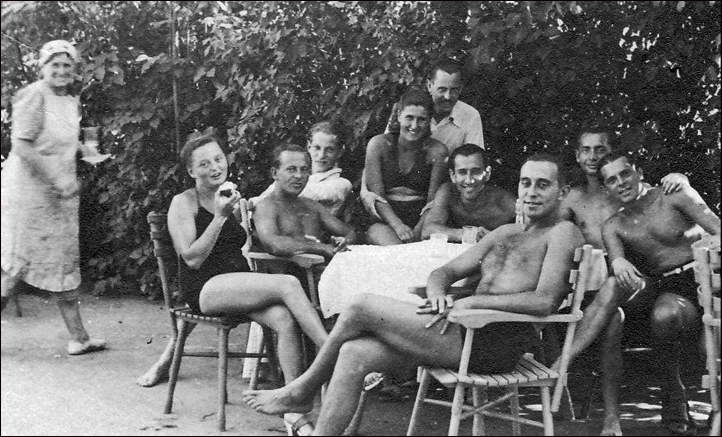
The Yiddish-inspired term of "ILSA-kibbitz" was often used to describe yet another group of club members, specifically those who were not engaged in competitive sports, yet were often present in and around the swimming pool. For those folks, ILSA was a recreational facility where they could go for a casual swim, watch a sporting event, socialize or just sunbathe.
THREE SIGNIFICANT LOCATIONS
While most successes achieved by the city's swimmers and players are tied to the factory's swimming pool, two other locations are noteworthy.
The oddly-sized Igiena pool was built by the Austro-Hungarian military in the mid-19th century. Having been Timisoara's only usable swimming pool, the Igiena pool served as the training facility for all the swimming and water polo clubs of the city. Established in 1933, ILSA's swimming and water polo club was training there as well. The closure of the Igiena pool in 1937 had a silver lining, though, as it pushed ILSA to build its own pool.
While most successes achieved by the city's swimmers and players are tied to the factory's swimming pool, two other locations are noteworthy.
The oddly-sized Igiena pool was built by the Austro-Hungarian military in the mid-19th century. Having been Timisoara's only usable swimming pool, the Igiena pool served as the training facility for all the swimming and water polo clubs of the city. Established in 1933, ILSA's swimming and water polo club was training there as well. The closure of the Igiena pool in 1937 had a silver lining, though, as it pushed ILSA to build its own pool.
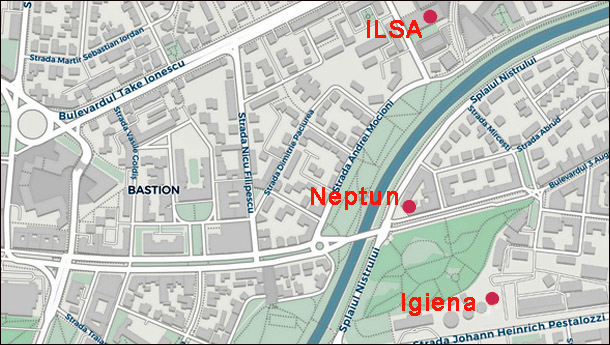
For a few years during the second half of the 1960s, swimmers trained year-round at the outdoor pool, under rather harsh conditions, but other than that, all winter training took place in the tiny and utterly inadequate pool of the old Neptun Baths.
ILSA OLYMPIANS
Norman Zoltan… Török Gabor… Octavian Iosim… Hoszpodar Zoltan... Novak Jozsef...
Balint Adalbert… Koszta Ladislau… Lovas Peter... Toth Timea
These are the seven athletes and two coaches who took part in five different Olympic Games, with one necessary clarification: at the Helsinki Games, Török Gabor fulfilled a double role of player and coach.
Norman Zoltan… Török Gabor… Octavian Iosim… Hoszpodar Zoltan... Novak Jozsef...
Balint Adalbert… Koszta Ladislau… Lovas Peter... Toth Timea
These are the seven athletes and two coaches who took part in five different Olympic Games, with one necessary clarification: at the Helsinki Games, Török Gabor fulfilled a double role of player and coach.
Visit the Olympians page to learn about these outstanding people who were part of the Olympic Games held in Helsinki (1952), Melbourne (1956), Rome (1960), Mexico City (1968) and Barcelona (1992).

KOSZTA LADISLAU & VASILE COSTA… TWO NAMES, ONE SWIMMER
ILSA has produced many champions in the sport of swimming, but when it comes to results on the international stage, Koszta Ladislau is in a class all by himself. He burst onto the national swimming scene in 1964 and all those who knew him were shocked to see that Sportul Popular, Romania's daily sports newspaper of national circulation, had renamed him Vasile Costa, without his permission. This made-up name appeared in print hundreds of times, in multiple newspapers, throughout Koszta's prolific athletic career.
ILSA has produced many champions in the sport of swimming, but when it comes to results on the international stage, Koszta Ladislau is in a class all by himself. He burst onto the national swimming scene in 1964 and all those who knew him were shocked to see that Sportul Popular, Romania's daily sports newspaper of national circulation, had renamed him Vasile Costa, without his permission. This made-up name appeared in print hundreds of times, in multiple newspapers, throughout Koszta's prolific athletic career.
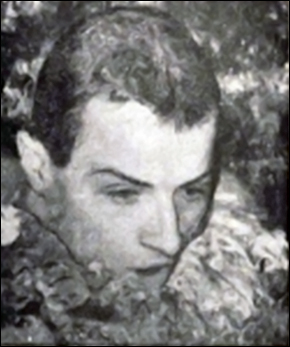

Newspaper editors worked extra hard to ensure the consistent use of the Vasile Costa moniker, yet they slipped up once, in 1970, when they published an article that included Koszta's real name. This one-off lapse must have puzzled all those who had been following the career of "Vasile Costa".
1939 - ILSA BUILDS ITS OWN SWIMMING POOL
The ILSA swimming and water polo club was established in 1933, at a time when the factory did not have a pool of its own. Practicing at the old Igiena pool, the city's only useable facility at that time, ILSA emerged in almost no time as one of the country's strongest clubs in both swimming and water polo.
Overall, the conditions at the Igiena pool were not favorable, as the fees were high and the hours allotted for training were limited. Then, in 1937, the ultimate blow: the Igiena pool closed down permanently, leaving ILSA without a place to train and forcing their swimmers and water polo team to withdraw from all national competitions. Pushed by these events, the factory's management decided to build a pool of their own.
Financed by the factory without the city's help, the project was completed in June 1939 and on July 1, 1939, hundreds of spectators and many newspaper reporters witnessed the inauguration of ILSA's brand-new pool. The event garnered nation-wide attention.
The ILSA swimming and water polo club was established in 1933, at a time when the factory did not have a pool of its own. Practicing at the old Igiena pool, the city's only useable facility at that time, ILSA emerged in almost no time as one of the country's strongest clubs in both swimming and water polo.
Overall, the conditions at the Igiena pool were not favorable, as the fees were high and the hours allotted for training were limited. Then, in 1937, the ultimate blow: the Igiena pool closed down permanently, leaving ILSA without a place to train and forcing their swimmers and water polo team to withdraw from all national competitions. Pushed by these events, the factory's management decided to build a pool of their own.
Financed by the factory without the city's help, the project was completed in June 1939 and on July 1, 1939, hundreds of spectators and many newspaper reporters witnessed the inauguration of ILSA's brand-new pool. The event garnered nation-wide attention.
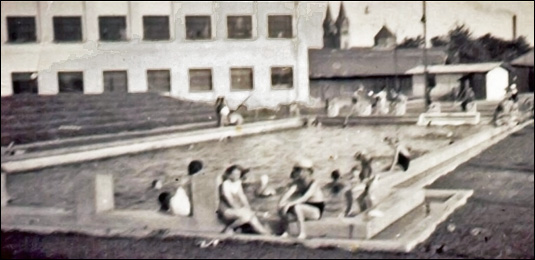
Located right next to the factory's oldest production building, the pool had a length of 33.33 meters and featured six lanes. The inauguration of the new pool gave further impetus to Timisoara's water sports, but at the same time, the city missed a rare opportunity to possess an Olympic pool (50 meters long, eight lanes) at a time when such pools were a rarity in the country.
With a width of only twelve meters, the pool was initially accepted by the Romanian Swimming Federation, but more than five decades later, during the late 1990s, the pool lost its official certification precisely because of its narrow width.
In 1947, the ILSA pool hosted Romania's swimming, water polo and diving national championships, with athletes from Bucharest, Cluj, Târgu Mureș, Oradea, Arad, Baia Mare and, of course, the locals. It was the first and last time that the national finals took place in Timisoara.
With a width of only twelve meters, the pool was initially accepted by the Romanian Swimming Federation, but more than five decades later, during the late 1990s, the pool lost its official certification precisely because of its narrow width.
In 1947, the ILSA pool hosted Romania's swimming, water polo and diving national championships, with athletes from Bucharest, Cluj, Târgu Mureș, Oradea, Arad, Baia Mare and, of course, the locals. It was the first and last time that the national finals took place in Timisoara.
A FEW TECHNICAL DETAILS
ILSA's swimming pool had its water pumped in directly from the nearby Bega River, hence its dark greenish hue. In the absence of a meaningful filtration system, the water was not particularly transparent, which made the already difficult task of refereeing a water polo game even tougher.
To keep the surface of the water as calm as possible, the pool was built with a wave breaker located just below the top of the walls, see item 3 in the sketch below. Not nearly as good as today's wave-breaking methods, ILSA's approach was not particularly effective.
With cleanliness in mind, a foot-wash that encircled the pool was also provided, see item 4 below. Multiple small canals (item 6) fed water from the pool into the foot-wash, for people to rinse their feet before entering the pool. This system was rather unique, not seen anywhere else in the country.
ILSA's swimming pool had its water pumped in directly from the nearby Bega River, hence its dark greenish hue. In the absence of a meaningful filtration system, the water was not particularly transparent, which made the already difficult task of refereeing a water polo game even tougher.
To keep the surface of the water as calm as possible, the pool was built with a wave breaker located just below the top of the walls, see item 3 in the sketch below. Not nearly as good as today's wave-breaking methods, ILSA's approach was not particularly effective.
With cleanliness in mind, a foot-wash that encircled the pool was also provided, see item 4 below. Multiple small canals (item 6) fed water from the pool into the foot-wash, for people to rinse their feet before entering the pool. This system was rather unique, not seen anywhere else in the country.
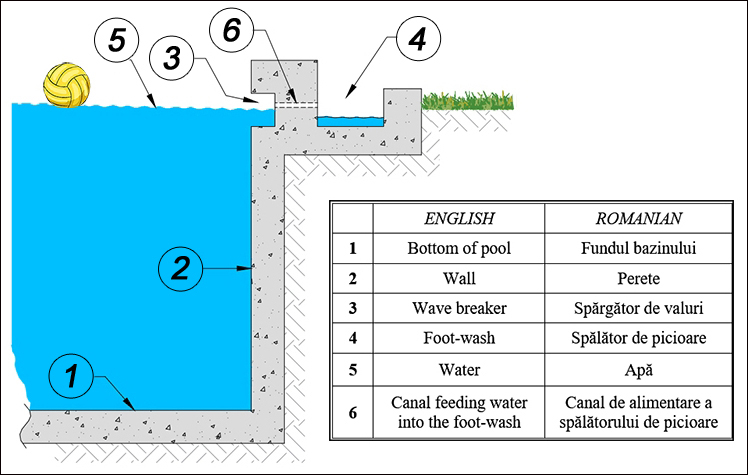
A few years after the pool's inauguration, the management added a much needed water heating system that consisted of a single steam pipe coming from the factory and entering the pool at the deep end. The bursts of pressure that forced the steam into the water produced loud thumping noises and vibrations that could be felt even at the opposite end of the pool. Most of the time, the hot steam pipe remained uninsulated, but people quickly learned to stay away from it.

Other than the valve that is visible in the picture, there were no controls of any kind. This system produced uneven water temperatures across the pool, with most folks preferring to congregate near the steam pipe.
SPECTATOR SEATING - A FLUID THING
During the early days of the Igiena pool, water polo matches and swim meets attracted crowds sometimes in excess of one thousand people. Taking this into account, ILSA's new pool was provided from the beginning with ample spectator seating.
Instead of employing conventional bleachers, the builders of the pool used some of the excavated soil to create a man-made hill running along two of the four sides of the pool. The hill was then reshaped to create six grass-covered tiers with a total seating capacity estimated to be around 800 spectators. Standing room viewing from the other two sides of the pool was also available.
During the early days of the Igiena pool, water polo matches and swim meets attracted crowds sometimes in excess of one thousand people. Taking this into account, ILSA's new pool was provided from the beginning with ample spectator seating.
Instead of employing conventional bleachers, the builders of the pool used some of the excavated soil to create a man-made hill running along two of the four sides of the pool. The hill was then reshaped to create six grass-covered tiers with a total seating capacity estimated to be around 800 spectators. Standing room viewing from the other two sides of the pool was also available.
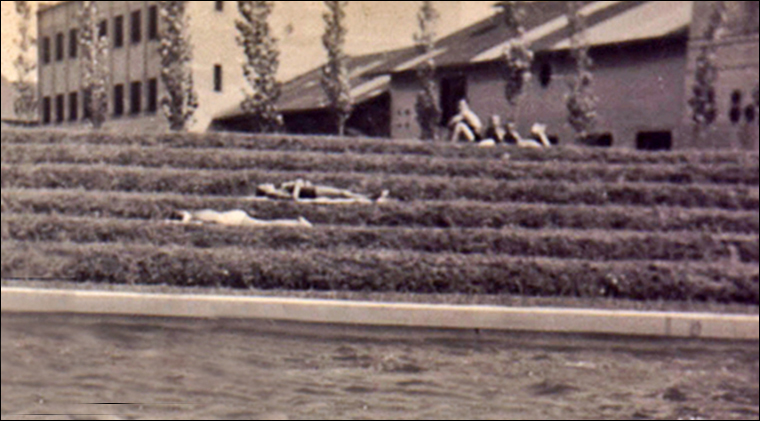
The original tiered seating turned out to be difficult to maintain, so during the early 1950s the hillside was once again reshaped to make it look more like a natural hill, with a sloping side.
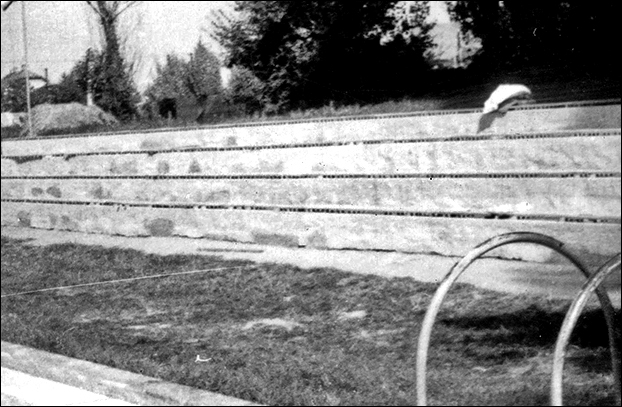
A third and final arrangement was implemented in 1962, when concrete bleachers were built along the two long sides of the pool. The bleachers remained in use until 1970, when they were demolished to make room for the pool's enclosure.
DIVING… THE SPORT THAT WASN'T TO BE
Built not too long after the pool's 1939 inauguration, ILSA's diving platform stood three meters above the deep end, where it lasted until 1970, when the pool became an indoor facility.
Initially, the platform was equipped with a springboard that later was permanently removed in the name of safety. In 1940, ILSA invited Alexandru Lascu, Romania's diving champion, to come to Timisoara and introduce his sport to a larger public. Lascu's demonstrations of serious and humorous dives were well received, but then the Second World War put everything on hold.
Built not too long after the pool's 1939 inauguration, ILSA's diving platform stood three meters above the deep end, where it lasted until 1970, when the pool became an indoor facility.
Initially, the platform was equipped with a springboard that later was permanently removed in the name of safety. In 1940, ILSA invited Alexandru Lascu, Romania's diving champion, to come to Timisoara and introduce his sport to a larger public. Lascu's demonstrations of serious and humorous dives were well received, but then the Second World War put everything on hold.
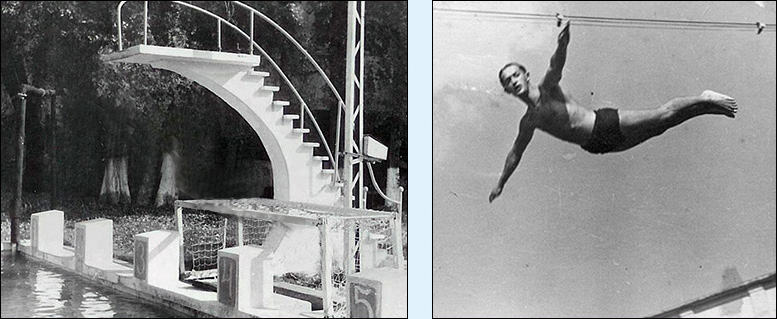
There have been no subsequent attempts to kickstart the sport of diving, so the platform remained there for everyone's use, just for fun. Swimmers were often seen playing a highly dynamic and spectacular game of water tag that involved swimming, running on dry land and jumps from the diving platform. The above photo shows Flesch Bandi, a member of ILSA's first water polo team.
1970 - ILSA ENCLOSES ITS SWIMMING POOL
Training during the cold months of the year had been a decades-long struggle that ended in 1970, when the factory built an enclosure around its swimming pool. As the city's only adequate indoor facility, the ILSA pool could finally host year-round training and competitions in both swimming and water polo.
Even though it lacked air conditioning and proper ventilation, the enclosed pool represented a major step in the right direction. Still, in 1975, a few groups of ILSA swimmers transferred to the newly inaugurated Circumvalațiunii indoor pool, which marked the beginning of the end of the sport of swimming at the factory's historic pool.
Training during the cold months of the year had been a decades-long struggle that ended in 1970, when the factory built an enclosure around its swimming pool. As the city's only adequate indoor facility, the ILSA pool could finally host year-round training and competitions in both swimming and water polo.
Even though it lacked air conditioning and proper ventilation, the enclosed pool represented a major step in the right direction. Still, in 1975, a few groups of ILSA swimmers transferred to the newly inaugurated Circumvalațiunii indoor pool, which marked the beginning of the end of the sport of swimming at the factory's historic pool.
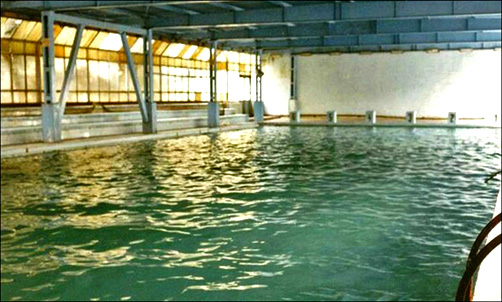
By the early 1980s, all swimming activities at the ILSA pool have ceased. The water polo team continued to train and play there until it disbanded during the late 1990s.
MAINTAINING THE POOL
For sanitary purposes, the pool was frequently emptied, scrubbed and refilled, an operation that in most cases started on Sunday afternoons and wrapped up just in time for Monday's training sessions.
Buckets filled with a mixture of lime and chlorine were dumped in the pool to sanitize the water and prevent the growth of algae on the walls of the pool. With swimming goggles yet to be invented, the sanitized water caused a strong burning sensation in the eyes of all those using the pool.
Two long-serving groundskeepers were instrumental in maintaining the club's facilities in good working order as well as setting the stage for workouts and competitions. Thanks to the efforts of Gyula-Bacsi (left photo) and Adrian Iancu (right) , the sports complex was always clean and in good working order.
For sanitary purposes, the pool was frequently emptied, scrubbed and refilled, an operation that in most cases started on Sunday afternoons and wrapped up just in time for Monday's training sessions.
Buckets filled with a mixture of lime and chlorine were dumped in the pool to sanitize the water and prevent the growth of algae on the walls of the pool. With swimming goggles yet to be invented, the sanitized water caused a strong burning sensation in the eyes of all those using the pool.
Two long-serving groundskeepers were instrumental in maintaining the club's facilities in good working order as well as setting the stage for workouts and competitions. Thanks to the efforts of Gyula-Bacsi (left photo) and Adrian Iancu (right) , the sports complex was always clean and in good working order.

Gyula-Bacsi's surname is not known. A former European rowing champion, he moved to Timisoara from Hungary during the mid-1930s and took charge of ILSA's large boat hangar and rowing docks. After the inauguration of the swimming pool, Gyula-Bacsi's duties expanded to include the maintenance of the pool as well. One of his many duties involved the distribution of milk and bread to the members of the swim team.
Known by everyone as Iancu-Baci, Adrian Iancu took the groundskeeper job sometime during the 1950s. During the years when ILSA had a full-size football field, Iancu-Baci was in charge of marking the field before games, among many other duties. After Gyula-Bacsi's retirement, Iancu took charge of the pool's maintenance as well. During the summer, every Sunday afternoon, he would get everyone out of the pool with his cries of "Toată lumea afară", meaning "Everybody out" in English, a step that preceded the emptying and cleaning of the pool. Iancu-Baci held the groundskeeper job until the late 1970s.
Known by everyone as Iancu-Baci, Adrian Iancu took the groundskeeper job sometime during the 1950s. During the years when ILSA had a full-size football field, Iancu-Baci was in charge of marking the field before games, among many other duties. After Gyula-Bacsi's retirement, Iancu took charge of the pool's maintenance as well. During the summer, every Sunday afternoon, he would get everyone out of the pool with his cries of "Toată lumea afară", meaning "Everybody out" in English, a step that preceded the emptying and cleaning of the pool. Iancu-Baci held the groundskeeper job until the late 1970s.
ILSA ON THE WEB
The idea of creating a website dedicated to ILSA first came up in 2002, during a conversation between Sergiu Morariu and Böhm Gabi, two former ILSA athletes who had just reconnected via the Internet.
Conceived and built by Böhm Gabi, ILSA's first-ever website (www.ilsa-timisoara.net) was launched in December 2002, with significant contributions from Sergiu and other former athletes and coaches. The site turned out to be a success but it became outdated as years went by.
The idea of creating a website dedicated to ILSA first came up in 2002, during a conversation between Sergiu Morariu and Böhm Gabi, two former ILSA athletes who had just reconnected via the Internet.
Conceived and built by Böhm Gabi, ILSA's first-ever website (www.ilsa-timisoara.net) was launched in December 2002, with significant contributions from Sergiu and other former athletes and coaches. The site turned out to be a success but it became outdated as years went by.

Built by the technically savvy George Savii and featuring new content curated by the same Böhm Gabi, this website launched in 2024, with the goal of preserving an important page of the city's athletic past.
The creators of this site hope that the people of Timisoara will find these pages informational, engaging and maybe even inspirational.
The creators of this site hope that the people of Timisoara will find these pages informational, engaging and maybe even inspirational.

